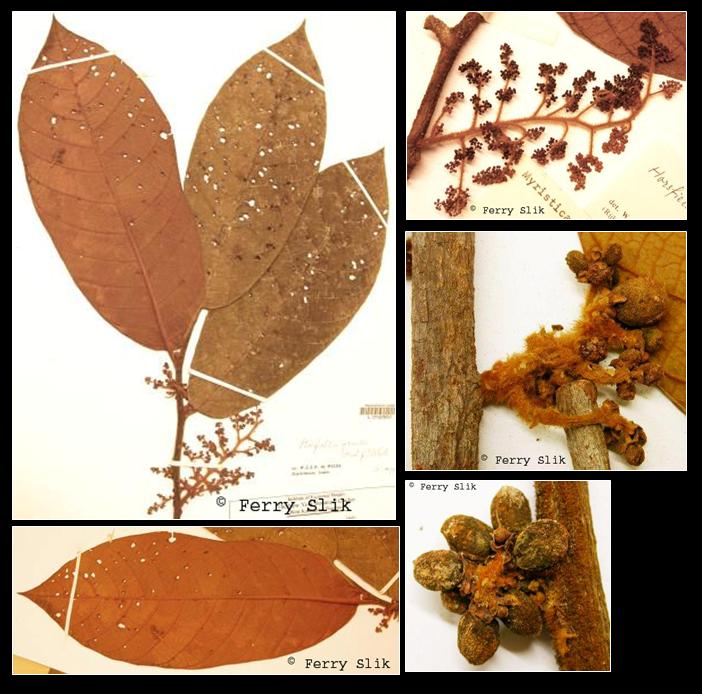Horsfieldia grandis (Hook.f.) Warb., Mon. Myrist. (1897)
Latin for 'large'.Synonyms
Myristica grandis Hook.f.
Myristica rubiginosa King
Diagnostics
Understorey tree up to 25 m tall and 31 cm dbh. Stem with red sap. Stipules
absent. Leaves alternate, simple, penni-veined, densely hairy below. Flowers ca.
2 mm diameter, green-yellow, placed in panicles. Fruits ca. 13 mm long, orange,
glabrous, dehiscent capsules. Seeds with undivided orange aril.
Description
Tree 6-25 m. Twigs (3-)4-10 mm diameter, late glabrescent, the hairs dense, harsh,
1-1.5 mm long; bark coarsely striate, sometimes slightly cracking, or flaking; lenticels
often present, somewhat elongate, inconspicuous. Leaves membranous or chartaceous,
+/- bullate, elliptic-oblong to oblong-oblanceolate, 12-40 by 5-20 cm, base +/- attenuate to
subcordate, apex acute or acute-acuminate; upper surface drying olivaceous, minutely
paler pustulate, with harsh, persistent sparse hairs, sometimes glabrescent but always
scabrous by harsh hair bases, lower surface with persistent dense to sparse harsh-woolly
hairs 1-2 mm long; dots absent; midrib somewhat raised above, harsh-pubescent; nerves
(8-)10-16(-19) pairs, flattish or usually sunken above, lines of interarching distinct;
venation lax, distinct on both surfaces (especially below); petiole 6-15 by 2.5-6 mm,
pubescent; leaf bud short-conical, 7-15 mm long, densely pubescent. Inflorescences
with dense yellow-rusty hairs, 1.5-3 mm long; in male: many-flowered, 3 or 4 times
branched, rather lax, 6-25 by 2.5-10(-15) cm, peduncle up to 1.2 cm long; in female;
1.5-5 cm long, the buds often of different age; bracts oblong to lanceolate-linear, (1-)3-
12 mm long, caducous; flowers solitary or usually (in male) in loose clusters, often aggregated
into compound clusters corresponding to the main ramifications of the inflorescences,
glabrous; perianth 3- or 4-lobed, pedicel slender, not articulated. Maleflowers:
pedicel (0.5-)1-2 mm long; buds globose or depressed-globose, 1.2-1.8(-2) mm diameter,
apex (broadly) rounded, base rounded, cleft c. 1/3 to nearly 1/2, lobes 0.2 mm
thick; androecium depressed globose, not laterally compressed, 0.5-1 by 0.8-1.5 mm,
thecae 16-20, almost completely sessile, incurved towards the apex, column
broad, hollow 0.2 mm deep; androphore narrow, 0.2-0.4 mm long. Female flowers:
pedicel 0.3-0.5 mm long; buds subglobose to broadly ellipsoid, 2-3.2 by 2-2.8 mm,
cleft 1/4-1/3; ovary globose to broadly ellipsoid, 1.5-2 by 1.5-1.8 mm, glabrous, stigma
sessile, faintly 2-lobed, 0.2 mm high. Fruits 2-10 per infructescence, +/- clustered, obovoid-
ellipsoid, apex rounded, 1-1.4 by 0.8-1.1 cm, glabrous; pericarp 1.5 mm thick, drying
dark brown or reddish brown, without lenticels or warts; seed almost globose, 8-10 mm
diameter; fruiting pedicel 1 mm long; perianth persistent. [from Flora Malesiana]
Ecology
In undisturbed to slightly disturbed (open) mixed dipterocarp and swamp
forests up to 600 m altitude. Common along rivers and streams, but also on
hillsides and ridges. On clay to sandy soils.
Uses
The wood is locally used to carve rice-field (padi) guards. The sap is used
to treat broken lips and mouth ulcers. Fruits said to be edible after beating.
Distribution
Peninsular Malaysia, Sumatra, Borneo.
Local names
Borneo: Dara-dara, Kumpang, Kumpang api, Pendarahan.
